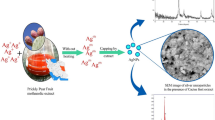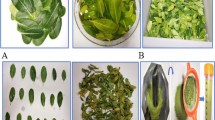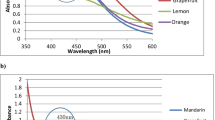Abstract
Current methods for green synthesis of metal nanoparticles often require continuous harvesting of fresh bio-materials for every synthesis cycle. Practices and procedures that economize bio-materials need to be employed if green synthesis could become a sustainable and eco-friendly method for synthesizing metal nanoparticles. This study explores Chrysophyllum albidum peels (mostly regarded as waste) to prepare silver nanoparticles (Alb-AgNPs). The technique employed in the synthesis allows repeated use of the peels, thus, reducing the heavy dependence on bio-materials. The optical and structural properties of the Alb-AgNPs were studied with Scanning electron microscope, Fourier transform infrared spectrometer, UV-Vis spectrophotometer and powder X-ray diffractometer. The antimicrobial properties of the Alb-AgNPs were studied with selected microorganisms namely; S. aureus, E. coli, K. pneumoniae, B. subtilis, S. mutans, P. aeruginosa, S. typhi, and Candida albicans. High inhibitory activity against the microorganisms were exhibited with MICs ranging from 15.62 to 1000 µg/mL. Again, the Alb-AgNPs showed the ability to enhance the efficacy of standard antimicrobial agents. The results of the combined interaction with standard antibacterial and antifungal agents ranged from synergistic to antagonistic effects against the tested microorganisms. In addition, the Alb-AgNPs could serve as a biofilm inhibitor with the highest percent inhibition of about 92% against methicillin-resistant Staphylococcus aureus. The results from this study thus provide access to the simple, sustainable, economic and eco-friendly synthesis of silver nanoparticles with efficient antimicrobial properties as drug candidates as a means of overcoming the prevailing antibiotic resistance menaces.





Similar content being viewed by others
References
Aabed K, Mohammed AE (2021) Synergistic and antagonistic effects of biogenic silver nanoparticles in combination with antibiotics against some pathogenic microbes. Front Bioeng Biotechnol 9:1–14. https://doi.org/10.3389/fbioe.2021.652362
Ahmed KBA, Senthilnathan R, Megarajan S, Anbazhagan V (2015) Sunlight mediated synthesis of silver nanoparticles using redox phytoprotein and their application in catalysis and colorimetric mercury sensing. J Photochem Photobiol B Biol 151:39–45. https://doi.org/10.1016/j.jphotobiol.2015.07.003
Anees Ahmad S, Sachi Das S, Khatoon A et al (2020) Bactericidal activity of silver nanoparticles: a mechanistic review. Mater Sci Energy Technol 3:756–769. https://doi.org/10.1016/j.mset.2020.09.002
Asare IK, Okyere AA, Duah-bissiw D et al (2015) Nutritional and phytochemical constituents of the African star apple (Chrysophyllum albidum g. Don). Ann Food Sci Technol 16:138–146
Bahrulolum H, Nooraei S, Javanshir N et al (2021) Green synthesis of metal nanoparticles using microorganisms and their application in the agrifood sector. J Nanobiotechnology 191(19):1–26. https://doi.org/10.1186/S12951-021-00834-3
Balakrishnan S, Ibrahim KS, Duraisamy S et al (2020) Antiquorum sensing and antibiofilm potential of biosynthesized silver nanoparticles of Myristica fragrans seed extract against MDR Salmonella enterica serovar Typhi isolates from asymptomatic typhoid carriers and typhoid patients. Environ Sci Pollut Res 27:2844–2856. https://doi.org/10.1007/s11356-019-07169-5
Bankar A, Joshi B, Ravi Kumar A, Zinjarde S (2010) Banana peel extract mediated synthesis of gold nanoparticles. Colloids Surf B Biointerfaces 80:45–50. https://doi.org/10.1016/J.COLSURFB.2010.05.029
Barapatre A, Aadil KR, Jha H (2016) Synergistic antibacterial and antibiofilm activity of silver nanoparticles biosynthesized by lignin-degrading fungus. Bioresour Bioprocess 3:1–13. https://doi.org/10.1186/s40643-016-0083-y
Brayner R (2008) The toxicological impact of nanoparticles. Nano Today 3:48–55. https://doi.org/10.1016/S1748-0132(08)70015-X
Espinosa-Cristóbal LF, Martínez-Castañón GA, Martínez-Martínez RE et al (2009) Antibacterial effect of silver nanoparticles against Streptococcus mutans. Mater Lett 63:2603–2606. https://doi.org/10.1016/j.matlet.2009.09.018
Fayaz AM, Balaji K, Girilal M et al (2010) Biogenic synthesis of silver nanoparticles and their synergistic effect with antibiotics: a study against gram-positive and gram-negative bacteria. Nanomed Nanatechnol Biol Med 6:103–109. https://doi.org/10.1016/J.NANO.2009.04.006
Folasade OA, Modupeola AO, Oluwatosin (2019) Phytochemical components of beverages from african star apple (Chrysophyllum albidum) tissue fractions under ambient storage. Afr J Food Sci 13:225–234. https://doi.org/10.5897/ajfs2019.1846
Gajbhiye M, Kesharwani J, Ingle A et al (2009) Fungus-mediated synthesis of silver nanoparticles and their activity against pathogenic fungi in combination with fluconazole. Nanomed Nanatechnol Biol Med 5:382–386. https://doi.org/10.1016/J.NANO.2009.06.005
Gloria Martin KD, Vergara Padilla KG (2020) Sunlight mediated synthesis of silver nanoparticles by Bacillus sp and its antibacterial property. Orient J Chem 36:419–424. https://doi.org/10.13005/ojc/360309
Goswami SR, Sahareen T, Singh M, Kumar S (2015) Role of biogenic silver nanoparticles in disruption of cell-cell adhesion in Staphylococcus aureus and Escherichia coli biofilm. J Ind Eng Chem 26:73–80. https://doi.org/10.1016/j.jiec.2014.11.017
Helmlinger J, Sengstock C, Groß-Heitfeld C et al (2016) Silver nanoparticles with different size and shape: equal cytotoxicity, but different antibacterial effects. RSC Adv 6:18490–18501. https://doi.org/10.1039/c5ra27836h
Huang J, Li Q, Sun D et al (2007) Biosynthesis of silver and gold nanoparticles by novel sundried Cinnamomum camphoraleaf. Nanotechnology 18:105104. https://doi.org/10.1088/0957-4484/18/10/105104
Hsueh YH, Lin KS, Ke WJ et al (2015) The antimicrobial properties of silver nanoparticles in bacillus subtilis are mediated by released ag + ions. PLoS ONE 10:1–17. https://doi.org/10.1371/journal.pone.0144306
Huq MA, Akter S (2021) Biosynthesis, characterization and antibacterial application of novel silver nanoparticles against drug resistant pathogenic klebsiella pneumoniae and salmonella enteritidis. Molecules 26:1–15. https://doi.org/10.3390/molecules26195996
Jelin F, Selva Kumar S, Malini M et al (2015) Environmental-assisted green approach AgNPs by nutmeg (Myristica fragrans): inhibition potential accustomed to pharmaceuticals. Eur J Biomed Pharm Sci 2:258–274
Joo HS, Otto M (2012) Molecular basis of in vivo biofilm formation by bacterial pathogens. Chem Biol 19:1503–1513. https://doi.org/10.1016/j.chembiol.2012.10.022
Khanna P, Kaur A, Goyal D (2019) Algae-based metallic nanoparticles: synthesis, characterization and applications. J Microbiol Methods 163:105656. https://doi.org/10.1016/J.MIMET.2019.105656
Khodavandi A, Alizadeh F, Aala F et al (2010) In vitro investigation of antifungal activity of allicin alone and in combination with azoles against Candida species. Mycopathologia 169:287–295. https://doi.org/10.1007/S11046-009-9251-3
Krithiga N, Rajalakshmi A, Jayachitra A (2015) Green synthesis of silver nanoparticles using leaf extracts of Clitoria ternatea and Solanum nigrum and study of its antibacterial effect against common nosocomial pathogens. J Nanosci 2015:1–8. https://doi.org/10.1155/2015/928204
Lara HH, Romero-Urbina DG, Pierce C et al (2015) Effect of silver nanoparticles on Candida albicans biofilms: an ultrastructural study. J Nanobiotechnol 13:1–12. https://doi.org/10.1186/s12951-015-0147-8
Latha M, Priyanka M, Rajasekar P et al (2016) Biocompatibility and antibacterial activity of the Adathoda vasica Linn extract mediated silver nanoparticles. Microb Pathog 93:88–94. https://doi.org/10.1016/J.MICPATH.2016.01.013
Li J, Rong K, Zhao H et al (2013) Highly selective antibacterial activities of silver nanoparticles against bacillus subtilis. J Nanosci Nanotechnol 13:6806–6813. https://doi.org/10.1166/jnn.2013.7781
Lieu YS, Chang YC, Chen HH (2018) Synthesis of silver nanoparticles by using rice husk extracts prepared with acid–alkali pretreatment extraction process. J Cereal Sci 82:106–112. https://doi.org/10.1016/J.JCS.2018.06.002
Mare AD, Ciurea CN, Man A et al (2021) In vitro antifungal activity of silver nanoparticles biosynthesized with beech bark extract. Plants 10:1–15. https://doi.org/10.3390/plants10102153
Masoud Hussein EA, Mohammad AAH, Harraz FA, Ahsan MF (2019) Biologically synthesized silver nanoparticles for enhancing tetracycline activity against Staphylococcus aureus and Klebsiella pneumoniae. Brazilian Arch Biol Technol 62:1–14. https://doi.org/10.1590/1678-4324-2019180266
Mo YY, Tang YK, Wang SY et al (2015) Green synthesis of silver nanoparticles using eucalyptus leaf extract. Mater Lett 144:165–167. https://doi.org/10.1016/J.MATLET.2015.01.004
Mohanta YK, Biswas K, Jena SK et al (2020) Anti-biofilm and antibacterial activities of silver nanoparticles synthesized by the reducing activity of phytoconstituents present in the Indian medicinal plants. Front Microbiol 11:1–15. https://doi.org/10.3389/fmicb.2020.01143
Nascimento Da Silva LC, Messias Sandes J, De Paiva MM et al (2013) Anti-Staphylococcus aureus action of three Caatinga fruits evaluated by electron microscopy. Nat Prod Res 27:1492–1496. https://doi.org/10.1080/14786419.2012.722090
Nester EW, Anderson D, Roberts CE Jr et al (2004) Microbiology A human perspective, 4th edn. McGraw-Hill, New York
Nguyen VT (2020) Sunlight-driven synthesis of silver nanoparticles using pomelo peel extract and antibacterial testing. J Chem 2020:1–9. https://doi.org/10.1155/2020/6407081
Parvekar P, Palaskar J, Metgud S et al (2020) The minimum inhibitory concentration (MIC) and minimum bactericidal concentration (MBC) of silver nanoparticles against Staphylococcus aureus. Biomater Investig Dent 7:105–109. https://doi.org/10.1080/26415275.2020.1796674
Philip D (2009) Biosynthesis of au, ag and Au-Ag nanoparticles using edible mushroom extract. Spectrochim Acta - Part A Mol Biomol Spectrosc 73:374–381. https://doi.org/10.1016/j.saa.2009.02.037
Pierce CG, Uppuluri P, Tristan AR et al (2008) A simple and reproducible 96-well plate-based method for the formation of fungal biofilms and its application to antifungal susceptibility testing. Nat Protoc 3:1494–1500. https://doi.org/10.1038/NPORT.2008.141
Pierce CG, Uppuluri P, Tummala S, Lopez-Ribot JL (2010) A 96 well microtiter plate-based method for monitoring formation and antifungal susceptibility testing of Candida albicans biofilms. J Vis Exp. https://doi.org/10.3791/2287
Pipattanachat S, Qin J, Rokaya D et al (2021) Biofilm inhibition and bactericidal activity of NiTi alloy coated with graphene oxide/silver nanoparticles via electrophoretic deposition. Sci Rep 11:1–9. https://doi.org/10.1038/s41598-021-92340-7
Right C, Alotaibi GF, Bukhari MA (2021) Factors influencing bacterial biofilm formation and development. Am J Biomed Sci Res 12:617–626. https://doi.org/10.34297/AJBSR.2021.12.001820
Rodríguez-Serrano C, Guzmán-Moreno J, Ángeles-Chávez C et al (2020) Biosynthesis of silver nanoparticles by Fusarium scirpi and its potential as antimicrobial agent against uropathogenic Escherichia coli biofilms. PLoS ONE 15:1–20. https://doi.org/10.1371/journal.pone.0230275
Sabine A (2017) Special feature GLOBAL PROSPECTS FOR MAJOR TROPICAL FRUITS 1 short-term outlook, challenges and opportunities in a vibrant global marketplace.Food outlook November:69–81
Sadeghi-Kiakhani M, Tehrani-Bagha AR, Miri FS et al (2022) Application of Achillea millefolium extract as a reducing agent for synthesis of silver nanoparticles (AgNPs) on the cotton: antibacterial, antioxidant and dyeing studies. BioMetals 2022 352 35:313–327. https://doi.org/10.1007/S10534-022-00366-9
Sartoratto A, Machado ALM, Delarmelina C et al (2004) Composition and antimicrobial activity of essential oils from aromatic plants used in Brazil. Brazilian J Microbiol 35:275–280. https://doi.org/10.1590/S1517-83822004000300001
Şeker Karatoprak G, Aydin G, Altinsoy B et al (2017) The effect of pelargonium endlicherianum fenzl. Root extracts on the formation of nanoparticles and their antimicrobial activities. Enzyme Microb Technol 97:21–26. https://doi.org/10.1016/J.ENZMICTEC.2016.10.019
Shankar SS, Ahmad A, Sastry M (2003) Geranium Leaf assisted biosynthesis of silver nanoparticles. Biotechnol Prog 19:1627–1631. https://doi.org/10.1021/bp034070w
Shu M, He F, Li Z et al (2020) Biosynthesis and antibacterial activity of silver nanoparticles using yeast extract as reducing and capping agents. Nanoscale Res Lett 15:1–9. https://doi.org/10.1186/S11671-019-3244-Z/FIGURES/7
Siddiqi KS, Husen A, Rao RAK (2018) A review on biosynthesis of silver nanoparticles and their biocidal properties. J Nanobiotechnol 16:1–28. https://doi.org/10.1186/s12951-018-0334-5
Skiba MI, Vorobyova VI (2019) Synthesis of silver nanoparticles using orange peel extract prepared by plasmochemical extraction method and degradation of methylene blue under solar irradiation. Adv Mater Sci Eng 2019:1–8. https://doi.org/10.1155/2019/8306015
Tkemaladze GS, Makhashvili KA (2016) Climate changes and photosynthesis. Ann Agrar Sci 14:119–126. https://doi.org/10.1016/J.AASCI.2016.05.012
Vanaja M, Annadurai G (2013) Coleus aromaticus leaf extract mediated synthesis of silver nanoparticles and its bactericidal activity. Appl Nanosci 3:217–223. https://doi.org/10.1007/s13204-012-0121-9
Vi TTT, Kumar SR, Huang YT et al (2020) Size-dependent antibacterial activity of silver nanoparticle-loaded graphene oxide nanosheets. Nanomaterials 10:1–18. https://doi.org/10.3390/nano10061207
Vijay Kumar PPN, Pammi SVN, Kollu P et al (2014) Green synthesis and characterization of silver nanoparticles using Boerhaavia diffusa plant extract and their anti bacterial activity. Ind Crops Prod 52:562–566. https://doi.org/10.1016/J.INDCROP.2013.10.050
Villanueva-Ibáñez M, Yañez-Cruz MG, Álvarez-García R et al (2015) Aqueous corn husk extract – mediated green synthesis of AgCl and Ag nanoparticles. Mater Lett 152:166–169. https://doi.org/10.1016/J.MATLET.2015.03.097
Vu XH, Duong TTT, Pham TTH et al (2018) Synthesis and study of silver nanoparticles for antibacterial activity against Escherichia coli and Staphylococcus aureus. Adv Nat Sci Nanosci Nanotechnol 9:1–7. https://doi.org/10.1088/2043-6254/aac58f
Yusefi M, Shameli K, Yee OS et al (2021) Green synthesis of fe3o4 nanoparticles stabilized by a garcinia mangostana fruit peel extract for hyperthermia and anticancer activities. Int J Nanomedicine 16:2515–2532. https://doi.org/10.2147/IJN.S284134
Zhang D, Ma XL, Gu Y et al (2020) Green synthesis of metallic nanoparticles and their potential applications to treat Cancer. Front Chem 8:1–18. https://doi.org/10.3389/fchem.2020.00799
Acknowledgements
Christopher Dawari of the University of Eastern Finland is acknowledged for their assistance in taking the SEM image of the nanoparticles.
Funding
No funding was received for conducting this study.
Author information
Authors and Affiliations
Corresponding author
Ethics declarations
Conflict of Interest
The authors declare that there is no competing interest.
Research involving humans and animals rights
This research does not involve humans and animals.
Informed consent
All authors authorize the publication of this manuscript.
Additional information
Publisher’s Note
Springer Nature remains neutral with regard to jurisdictional claims in published maps and institutional affiliations.
Rights and permissions
Springer Nature or its licensor (e.g. a society or other partner) holds exclusive rights to this article under a publishing agreement with the author(s) or other rightsholder(s); author self-archiving of the accepted manuscript version of this article is solely governed by the terms of such publishing agreement and applicable law.
About this article
Cite this article
Ankudze, B., Neglo, D. Green synthesis of silver nanoparticles from peel extract of Chrysophyllum albidum fruit and their antimicrobial synergistic potentials and biofilm inhibition properties. Biometals 36, 865–876 (2023). https://doi.org/10.1007/s10534-022-00483-5
Received:
Accepted:
Published:
Issue Date:
DOI: https://doi.org/10.1007/s10534-022-00483-5




